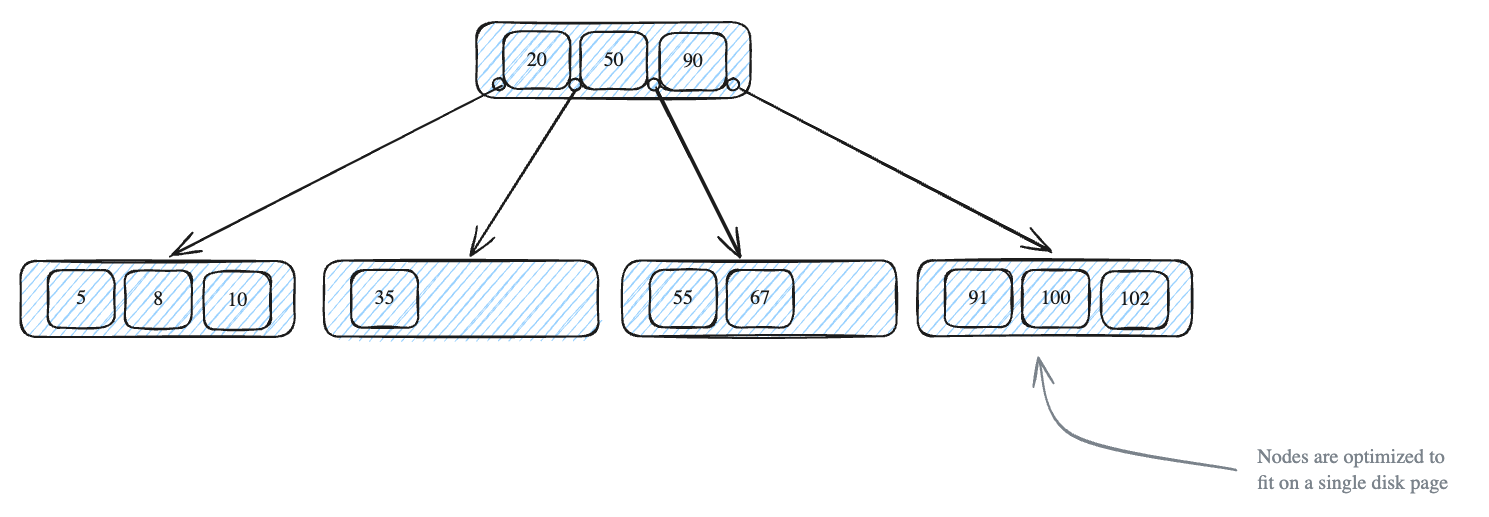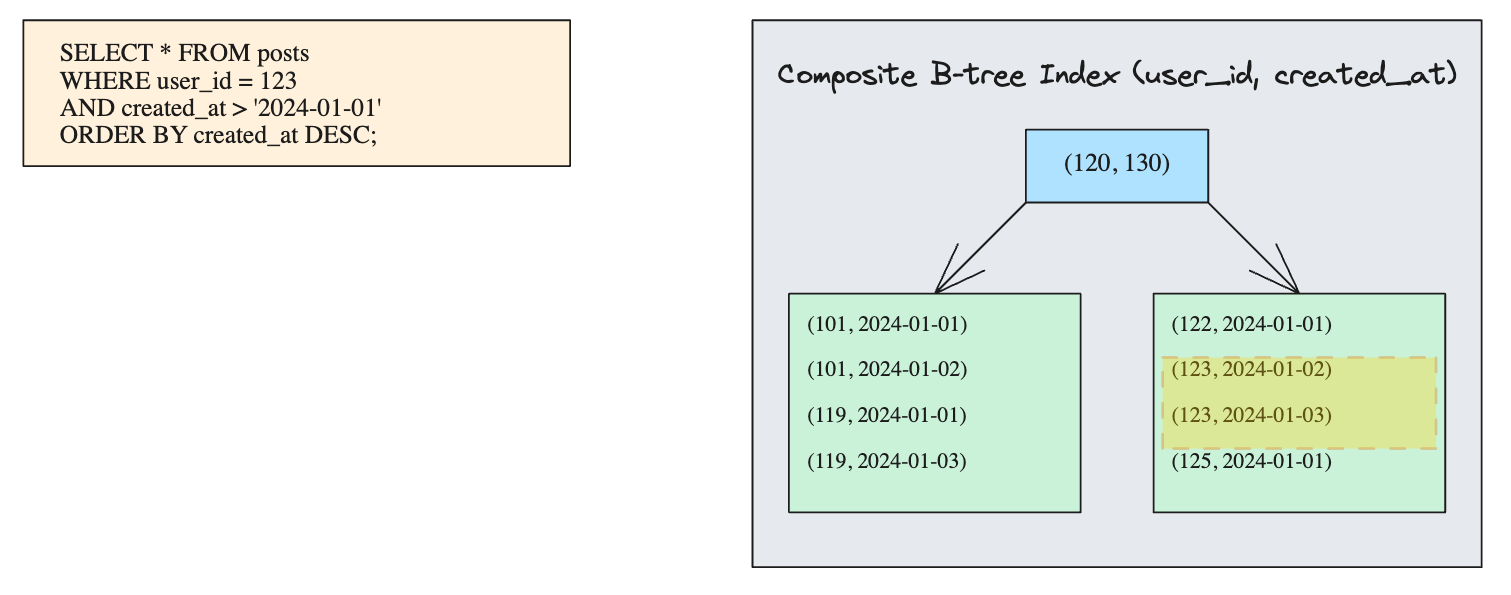Database Indexing
How Database Indexes Work
Physical Storage and Access Pattern
- Data lives on disk (typically SSDs nowadays), we can only process it when it's in memory.
The Cost of Indexing
- Every index we create requires additional disk space.
- When we insert a new row or update an existing row, we need to update the index.
- With multiple indexes, we need to update all indexes.
- Some classic case:
- Logging table
- Frequent writes but infrequent reads
- We constantly inserting new records but rarely querying old ones.
- Small tables with just few hundred rows
- The cost of maintaining an index and traversing its structure might exceed the cost of a simple sequential scan.
- Logging table
Pros and Cons of Indexing
Pros: Improve Query Performance
- If a query does not use an index, it will result in a full table scan, with a time complexity of
O(n). - However, if an index is used, the query can levearge a binary search algorithm to quickly locate the target data.
- The time complexity is
O(log_d n), where d is the maximum number of childs allowed for a node.
Cons:
- Indexes require physical storage space, and the more indexes there are, the more space they consume.
- Creating and maintaining indexes takes time, and this time increases as the data volume grows.
- Indexes slow down insert, delete, and update operations on the table. This is because the B-tree, used by the index, must be dynamically rotated to preserve its ordered structure each time the data is modified.
Index Types
B-Tree Indexes
- Fast searches and updates.
- Acheived by maintaining a balanced tree structure that minimizes the number of disk reads required to find a record.
Structure of B-Trees
- A B-Tree is a self-balancing tree that maintain sorted data and allows for efficient insertions, deletions, and searches.
- B-tree nodes can have multiple children - typlically hundreds in practice.
- Each node contains an ordered array of keys and pointes.

-
Every node in a B-tree follows strict rules:
- All leaf nodes must be at the same level (depth).
- A node with k keys must have exactly k+1 children.
- Keys within a node are kept in sorted order.
-
This structure maps perfectly to how databases store data on disk.
-
Each node is sized to fit in a single disk page (typically 8KB), maximizing our I/O efficiency.
Real-World Example
- PostgreSQL uses B-trees for primary keys, unique constraints, and most regular indexes.
CREATE TABLE users (
id SERIAL PRIMARY KEY,
email VARCHAR(255) UNIQUE
);
Why B-Trees Are the Default Choice
- Mintain sorted order, making range queries and ORDER BY operations efficient.
- Self-balancing, ensuring predictable performance even as data grows.
- Minimize disk I/O by matching their structure to how databases store data.
- Handle both equality searches (email = 'x') and range searches (age > 25) equally well.
- Remain balanced even with random inserts and deletes, avoiding the performance cliffs you might see with simpler tree structures.
Inverted Indexes
-
B-tree excels at finding exact matches and ranges, they fall short when we need to search through text content.
-
Why Index using B-tree not works?
SELECT * FROM posts WHERE content LIKE '%database%';- Even with a B-tree index on the content column, the database can't use the index at all.
- B-tree indexes can only help with prefix matches (like 'database%') or suffix matches (if you index the reversed content).
- When the pattern could match anywhere within the text, the database has no choice but to check every row.
-
How Inverted Indexes works?
- Think of it like the index at the back of a textbook.
doc1: "B-trees are fast and reliable"
doc2: "Hash tables are fast but limited"
doc3: "B-trees handle range queries well"
-- create a mapping of
b-trees -> [doc1, doc3]
fast -> [doc1, doc2]
reliable -> [doc1]
hash -> [doc2]
tables -> [doc2]
limited -> [doc2]
handle -> [doc3]
range -> [doc3]
queries -> [doc3] -
Trade-offs:
- When a document changes, we need to update entries for every term it contains.
Index Optimization Patterns
Composite Indexes
-
Instead of creating separate indexes for each column, we create a single index that combines multiple columns in a specific order.
-
Consider we create two separate indexes:
SELECT * FROM posts
WHERE user_id = 123
AND created_at > '2024-01-01'
ORDER BY created_at DESC;
CREATE INDEX idx_user ON posts(user_id);
CREATE INDEX idx_time ON posts(created_at);- But this isn't efficient. The database needs to:
- Use one index to find all the posts for user 123.
- Use another index to find all posits after 2024-01-01.
- Intersect these results.
- Sort the final results set by
created_at.
- But this isn't efficient. The database needs to:
-
When we use composite index,
CREATE INDEX idx_user_time ON posts(user_id, created_at);
- Each node's key in the B-tree is actually a tuple of the indexed columns.
- The keys are in sorted order based on
user_id, thencreated_at.Conceptual Ordering of Keys(1, 2024-01-01)
(1, 2024-01-02)
(1, 2024-01-03)
(2, 2024-01-01)
(2, 2024-01-02)
(3, 2024-01-01) - When we execute our query, the database can traverse the B-tree to find the first entry for
user_id=123, then scan sequentially through the index entries for that user. - Both filtering and sorting in the query are handled by a single index scan.
The Order Matters
-
Fields placed earlier in the index are more likely to be used for filtering.
-
Fields with high selectivity (or high cardinality) should be placed first, as they are more likely to be used by a wider range of SQL queries.
-
For example:
- A field like gender has low selectivity (e.g., only two values: male and female), making it unsuitable for indexing or for being placed early in a composite index.
- A field like UUID has high selectivity, making it ideal for indexing or being placed early in a composite index.
-
If an index has low selectivity and the values are evenly distributed, querying any value might return a large portion of the data (e.g., half the table).
Covering Indexes
- An index that contains all the columns required by a query, allowing the query to be completed without accessing the table's data rows.
- All the data needed for the query can be retrieved directly from the index.
- Improves query performance by reducing the number of data page accesses, thereby decreasing I/O operations.
CREATE TABLE employees (
id INT PRIMARY KEY,
name VARCHAR(100),
age INT,
department VARCHAR(100),
salary DECIMAL(10, 2)
);
CREATE INDEX idx_name_age_department ON employees(name, age, department);
SELECT name, age, department FROM employees WHERE name = 'John';
Situations Where Indexes Become Invalid
LIKE %xxorLIKE %xx%in LIKE Queries
- The index becomes invalid because the query cannot utilize the sorted structure of the index effectively.
- Using Functions on Indexed Columns in Query Conditions
SELECT * FROM users WHERE UPPER(username) = 'ALICE';
- Performing Expression Calculations on Indexed Columns
- If an indexed column is used in an expression (e.g.,
WHERE indexed_column + 1 = 5).
- Implicit Type Conversion Due to String-to-Number Comparison
- If the indexed column is a string and the query condition uses a numeric value (e.g.,
WHERE indexed_string_column = 123), an implicit type conversion occurs.
- Violating the Leftmost Matching Principle in Composite Indexes
- For composite indexes, queries must adhere to the leftmost matching principle, meaning the query must match the index fields in their defined order (left to right).
- Using OR with Mixed Indexed and Non-Indexed Columns
- In a
WHEREclause, if the condition before anORoperator uses an indexed column but the condition afterORuses a non-indexed column, the index becomes invalid.